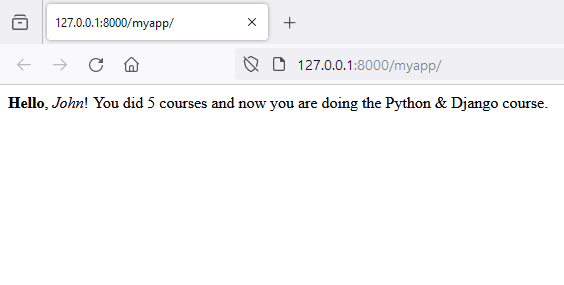Context And Variables
In a Django template you can use variables defined in your Python code. To do so, include these variables in a dictionary that is passed as the first argument to the render(). This dictionary is known as context. So, the context defines the variables that you want to be available in a template. For example:
def index(request: HttpRequest) -> HttpResponse:
ctx = {"name": "John"}
return render(request, "myapp/index.html", ctx)
The second line of this function defines the ctx dictionary in which you indicate that the name variable (in the template) has the value "John". Now, in the index.html template you can do:
<html>
<strong>Hello</strong>, <em>{{ name }}</em>!
</html>
And the result is, as expected:
What has happened here is that the render() function has replaced the {{ name }} portion of the template with the value assigned to that variable in the context (or, in other terms, in the case of a dictionary, the value that corresponds to that key in the context.) This method by which you indicate the name of a variable (defined in the context) between double curly braces to “print” its value in a template is one of the syntaxes of the Django template system that we mentioned above.
Let's add a few more things to the context to better illustrate this process:
def index(request: HttpRequest) -> HttpResponse:
ctx = {
"name": "John",
"courses": 5,
"current_course": "Python & Django"
}
return render(request, "myapp/index.html", ctx)
And in the template:
<html>
<strong>Hello</strong>, <em>{{ name }}</em>!
You did {{ courses }} courses and now you are doing the
{{ current_course }} course.
</html>
Now we see:

If the object between braces is a collection, you can access its elements from the template using a dot (note, again, that this is not Python syntax, although similar, but a specific syntax provided by the Django template system.) Examples:
def index(request: HttpRequest) -> HttpResponse:
ctx = {
"name": "John",
"courses": 5,
"current_course": {"name": "Python & Django", "time": "6:00 p.m."},
"previous_courses": ["Java", "PHP", "JavaScript", "Python"]
}
return render(request, "myapp/index.html", ctx)
And in index.html:
<html>
<strong>Hello</strong>, <em>{{ name }}</em>!
You did {{ courses }} courses and now you are doing the
{{ current_course.name }} course at {{ current_course.time }}
Your first course was {{ previous_courses.0 }}.
</html>